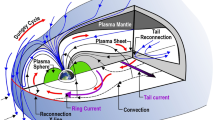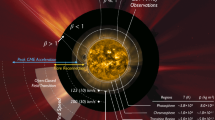Abstract
In each polar cap (PC) we mark out “old PC” observed during quiet time before the event under consideration, and “new PC” that emerges during the substorm framing the old one and expanding the PC total area. Old and new PCs are the areas for the magnetosphere old and new tail lobes, respectively. The new lobe variable magnetic flux Ψ1 is usually assumed to be active, i.e. it provides the electromagnetic energy flux (Poynting flux) ɛ′ transport from solar wind (SW) into the magnetosphere. The old lobe magnetic flux Ψ2 is supposed to be passive, i.e. it remains constant during the disturbance and does not participate in the transporting process which would mean the old PC electric field absolute screening from the convection electric field created by the magnetopause reconnection. In fact, screening is observed, but far from absolute. We suggest a model of screening and determine its quantitative characteristics in the selected superstorm. The coefficient of a screening is the β = Ψ2/Ψ02, where Ψ02 = const is open magnetic flux through the old PC measured prior to the substorm, and Ψ2 is variable magnetic flux through the same area measured during the substorm. We consider three various regimes of disturbance. In each, the coefficient β decreased during the loading phase and increased at the unloading phase, but the rates and amplitudes of variations exhibited a strong dependence on the regime. We interpreted decrease in β as a result of involving the old PC magnetic flux Ψ2, which was considered to be constant earlier, in the Poynting flux ɛ′ transport process from solar wind into the magnetosphere. Transport process weakening at the subsequent unloading phase creates increase in β. Estimates showed that coefficient β during each regime and the computed Poynting flux ɛ′ varied manifolds. In general, unlike the existing substorm conception, the new scenario describes an unknown earlier of tail lobe activation process during a substorm growth phase that effectively increases the accumulated tail energy for the expansion and recovery phases.
Similar content being viewed by others
References
Stern, D.P. and Alexeev, I.I., Where Do Field Lines Go in the Quiet Magnetosphere, Rev. Geophys., 1988, vol. 26, pp. 782–791.
Troshichev, O.A. and Nishida, A., Pattern of Electron and Ion Precipitation in Northern and Southern Polar Regions for Northward IMF, J. Geophys. Res., 1992, vol. 97, p. 8337.
Newell, P.T., Xu, D., Meng, C.-I., and Kivelson, M.G., The Dynamical Polar Cap: A Unifying Approach, J. Geophys. Res., 1997, vol. 102, p. 127.
Newell, P.T., Liou, K., Sotirelis, T., and Meng, Ching-I., Polar Ultraviolet Imager Observations of Global Auroral Power as a Function of Polar Cap Size and Magnetotail Stretching, J. Geophys. Res., 2001, vol. 106, no. 5A4, p. 5895.
Shukhtina, M.A., Dmitrieva, N.P., and Sergeev, V.A., Quantitative Magnetotail Characteristics of Different Magnetospheric States, Ann. Geophys., 2004, vol. 22, pp. 1019–1032.
Shukhtina, M.A., Dmitrieva, N.P., Popova, N.G., et al., Observational Evidence of the Loading-Unloading Scheme, Geophys. Res. Lett., 2005, vol. 32, p. L17107. doi: 10.1029/2005GL023779..
Maezawa, K., Magnetotail Boundary Motion Associated with Geomagnetic Substorms, J. Geophys. Res., 1975, vol. 80, pp. 3543–3548.
Mishin, V.M., The Magnetogram Inversion Technique: Applications to the Problem of Magnetospheric Substorms, Space Sci. Rev., 1991, vol. 57, pp. 237–337.
Mishin, V.M., Block, L.P., Bazarzhapov, A.D., et al., A Study of the CDAW9C Substorm, May 3, 1986 Using Magnetogram Inversion Technique 2, and a Substorm Scenario with Two Active Phases, J. Geophys. Res., 1997, vol. 102, p. 18425.
Mishin, V.M., Saifudinova, T.I., Bazarzhapov, A.D., et al., Two Distinct Substorm Onsets, J. Geophys. Res., 2001, vol. 106, no. A7, pp. 13105–13118. doi: 10.1029/2000JA900152.
Petrinec, S.M. and Russell, C.T., Near-Earth Magnetotail Shape and Size as Determined from the Magnetopause Flaring Angle, J. Geophys. Res., 1997, vol. 101, p. 137.
Baker, D.N., Pulkkinen, T.I., Hesse, H., and McPherron, A Quantitative Assessment of a Storage and Release Energy of the Earth’s Magnetotail, J. Geophys. Res., 1997, vol. 102, pp. 7159–7168.
Brittnacher, M., Fillingim, M., Parks, G., et al., Polar Cap Area and Boundary Motion during Substorms, J. Geophys. Res., 1999, vol. 104, pp. 12251–12262.
Milan, S.E., Lester, M., Cowley, S.W., et al., Variations of the Polar Cap Area during Two Substorm Cycles, Ann. Geophys., 2003, vol. 21, pp. 1121–1140.
Milan, S.E., Provan, G., and Hubert, B., Magnetic Flux Transport in the Dungey Cycle: A Survey of Dayside and Night Side Reconnection Rates, J. Geophys. Res., 2007, vol. 112, no. A01209. doi: 10.1029/2006JA011642.
Milan, S.E., Boakes, P.D., and Hubert, B., Response of the Expanding/Contracting Polar Cap to Weak and Strong Solar Wind Driving: 1. Implication for Substorm Onset, J. Geophys. Res., 2008, no. 113, p. A09215. doi: 10.1029/2008JA013340.
Mishin, V.M., Shirapov, D.Sh., Golovkov, V.P., and Forster, M., Field-Aligned Currents of Region 0, as an Electric Shield of the Polar Cap Ionosphere, in Auroral Phenomena and Solar-Terrestrial Relations, Zelenyi, L.M., Geller, M.A., and Allen, J.H., Eds., CAWSES Handbook, 2004, pp. 121–127.
Mishin, V.M. and Karavaev, Yu.A., Dynamics of Screening the Electric Field of the Polar Cap, Solnechno-Zemnaya Fizika, 2010, no. 15, pp. 75–81.
Shirapov, D.Sh. and Mishin, V.M., Modelirovanie global’nykh elektrodinamicheskikh protsessov v geomagnitosfere (Modeling of Global Electrodynamic Processes in the Earth’s Magnetosphere), Ulan-Ude: VSGTUS, 2009.
Gonzalez, W.D. and Mozer, F.S., A Quantitative Model for the Potential Resulting from Reconnection with an Arbitrary Interplanetary Magnetic Field, J. Geophys. Res., 1974, vol. 79, p. 4186.
Akasofu, S.-I., Energy Coupling between the Solar Wind and the Magnetosphere, Space Sci. Rev., 1981, vol. 28, pp. 121–190.
Mishin, V.M. and Falthammar, C.-G., Pseudo- and True Substorm Onsets within Framework of the Analogy “Magnetospheric Substorms — Solar Flares”, Substorms-4, Intern. Conf. on Substorms, Terra Sci. Publ. Comp., 1998, pp. 1067–1078.
Palmroth, M., Pulkkinen, T.I., Janhunen, P., and Wu, C.-C., Stormtime Energy Transfer in Global MHD Simulation, J. Geophys. Res., 2003, vol. 108, no. A1, p. 1048. doi: 10.1029/2002JA009446.
Birn, J. and Hesse, M., Reconnection in Substorms and Solar Flares: Analogies and Differences, Ann. Geophys., 2009, vol. 27, pp. 1067–1078.
Lui, A.T.Y. and Kamide, Y., A Fresh Perspective of the Current System and Its Dynamo, Geophys. Res. Lett., 2003, vol. 30, no. 18. doi: 10.1029/2003GL0017835.
Petrukovich, A.A., Small Substorms Solar Wind Input and Magnetotail Dynamics, J. Geophys. Res., 2000, vol. 105, pp. 109–118.
Sergeev, V.A., On the State of the Magnetosphere during Prolonged Periods of the Southward Oriented IMF, Phys. Solariterr., Potsdam, 1977, vol. 5, p. 39.
Lin, N. et al., Statistical Study of Substorm Timing Sequence, J. Geophys. Res., 2005, vol. 110, no. 08208. vol. 114, no.A12204. doi:10.1029/2009JA014381.
Lyons, L.R., Lee, D.-Y., Wang, C.-P., and Mende, S.B., Global Auroral Responses to Abrupt Solar Wind Changes: Dynamic Pressure, Substorm, and Null Events, J. Geophys. Res., 2005, vol. 110, no. 08208. doi: 10.1029/2005JA011089.
Lee, D.-Y., Lyons, L.R., Weygand, J.M., and Wang, C.-P., Reasons Why Some Solar Wind Changes Do Not Trigger Substorms, J. Geophys. Res., 2007, vol. 112, no. A06240. doi: 10.1029/2007JA012249.
Mishin, V.M., Shirapov, D.Sh., and Kokorina, E., Some Magnetospheric Effects of Nonmagnetized Solar Wind and Rounding by Convection of the Polar Cap Boundary, in Issled. po geomagnetizmu, aeronomii i fizike Solntsa (Studies in Geomagnetism, Aeronomy, and Physics of the Sun), Moscow: Nauka, 1987, issue 78, pp. 92–98.
Watanabe, M., Iijima, T., Nakagava, M., et al., Field-Aligned Current System in the Magnetospheric Ground State, J. Geophys. Res., 1998, vol. 103, pp. 6853–6869.
Kustov, A.V., Lyatskiy, W.B., Sofko, G.L., and Xu, L., Field-Aligned Currents in the Polar Cap at Small IMF Bz and By Inferred from SuperDarn Radar Observation, J. Geophys. Res., 2000, vol. 105, p. 205.
Karavaev, Yu.A., Sapronova, L.A., Bazarzhapov, A.D., et al., Energetics of the Magnetospheric Superstorm on November 20, 2003, Geomagnetism and Aeronomy, 2009, vol. 49, no. 7, pp. 961–969.
Mishin, V.M., The Magnetogram Inversion Technique and Some Application, Space Sci. Rev., 1990, vol. 53, pp. 83–163.
Lu, G., Reiff, P.H., Hairston, M.R., et al., Distribution of Convection Potential around the Polar Cap Boundary as a Function of the Interplanetary Magnetic Field, J. Geophys. Res., 1989, vol. 94, pp. 13447–13461.
Kamide, Y. and Baumjohann, W., Magnetosphere — Ionosphere Coupling, Berlin, Heidelberg: Springer, 1994.
Author information
Authors and Affiliations
Corresponding author
Additional information
Original Russian Text © V.M. Mishin, Yu.A. Karavaev, L.A. Sapronova, S.I. Solovyev, 2012, published in Kosmicheskie Issledovaniya, 2012, Vol. 50, No. 4, pp. 929–302.
The article was translated by the author.
Rights and permissions
About this article
Cite this article
Mishin, V.M., Karavaev, Y.A., Sapronova, L.A. et al. Activation of the tail open part during the magnetospheric storm. Cosmic Res 50, 272–281 (2012). https://doi.org/10.1134/S001095251204003X
Received:
Published:
Issue Date:
DOI: https://doi.org/10.1134/S001095251204003X




